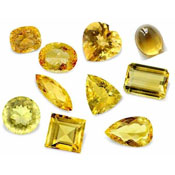Citrine
(si-treen)
HISTORY and LORE
- According to old legends, has the power to guard its wearer from evil thoughts.
- Name comes from Latin citrus meaning citron, a fruit related to lemon, lime, and orange.
- Birthstone for November and gem for the 13th wedding anniversary.
VALUE FACTORS
- Color: Light yellow to dark orange (sometimes brownish). Most expensive is rich deep “Madeira” orange.
- Clarity: Often almost inclusion free.
- Cut: Faceted in many shapes and styles. Also cabochons, carvings, fantasy cuts and beads.
- Carat Weight: Normally available in a very wide size range (up to 50 carats or more). One of the world’s biggest transparent faceted gems is a citrine that weighs 19,548 carats – or about 8.5 pounds.
TREATMENT
- Almost all citrine is produced by heat-treating pale amethyst. The process duplicates natural heating that can occur in the Earth. The effects are normally permanent, and the treatment creates no special care requirement.
GEMOLOGY
- A variety of quartz, the most abundant mineral species in the Earth’s crust.
- Composed almost entirely of silicon and oxygen: chemical formula SiO2.
- Sometimes confused with – or misrepresented as – topaz because of color similarity. Terms such as “citrine topaz” and “topaz quartz” and misnomers.
CARE
Citrine generally has good wearablility.
- Hardness: Moderate scratch resistance. Rates 7 on the Mohs Hardness Scale.
- Toughness: Good resistance to chipping and breaking.
- Stability: No routine concerns for gem owners.
- Cleaning: Liquid cleaner, or detergent and water. Ultrasonic is usually safe.
